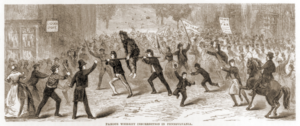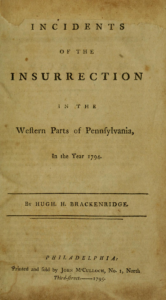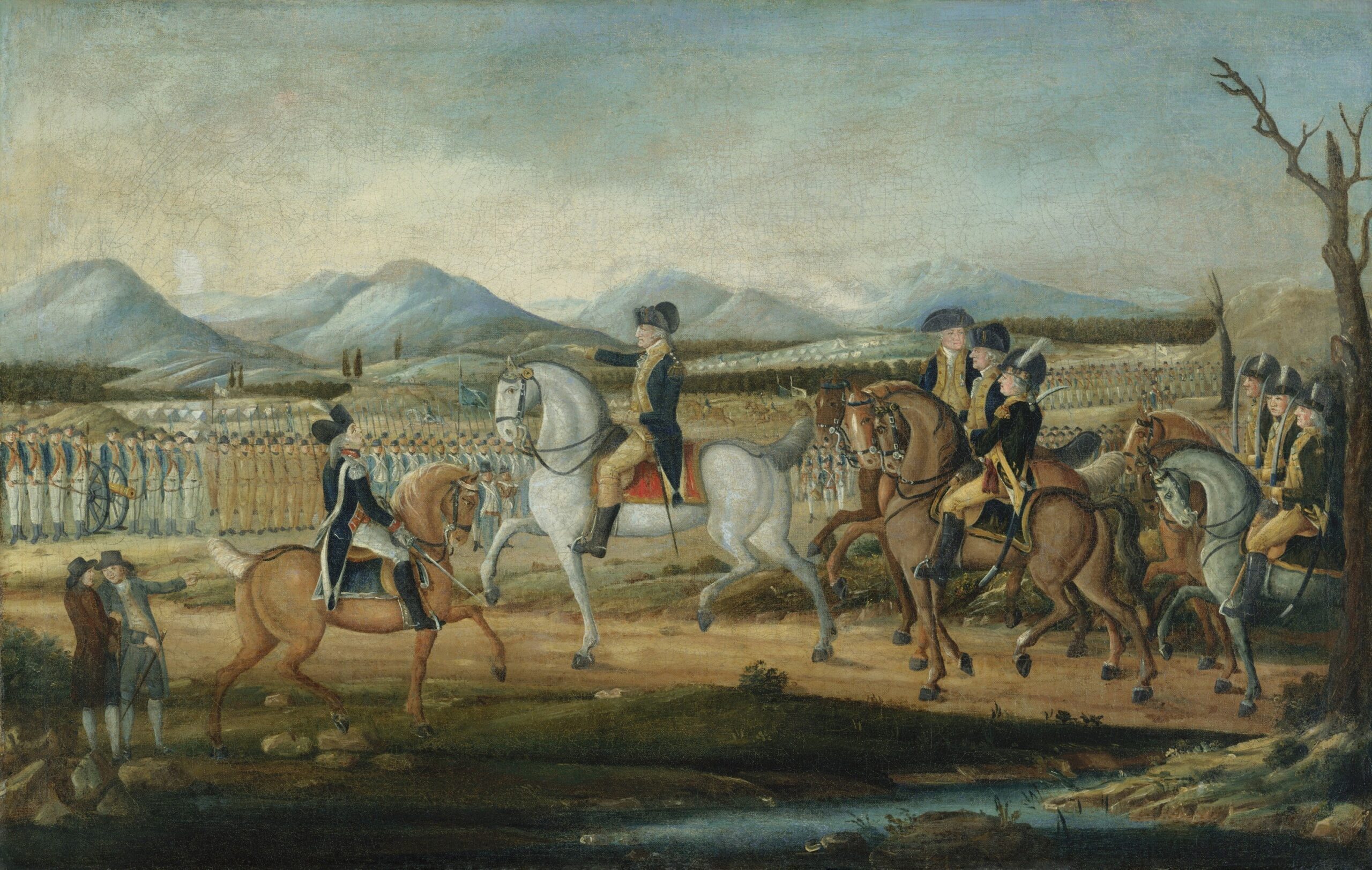The Whiskey Rebellion



Excerpt from “The Book of Bourbon” by Gary Regan and Mardee Haidin Regan
In 1791, George Washington approved an excise tax on liquor. He certainly wasn’t the first to take out his frustrations on whiskey-producers; just four years earlier Britain had introduced a prohibitive tax on Highland stills in Scotland and declared that the whisky produced there couldn’t be distributed outside the Highland region. Everyone seemed to have it out for the distillers.
But Washington had his reasons, and although he was himself a distiller, he listened to Alexander Hamilton, Secretary of the Treasury, who proposed that the newly formed country should pay off its debts from the Revolutionary War. To accomplish this, Hamilton persuaded Congress to introduce tariffs on imported goods, tax spirits, and charter the Bank of the United States, which would hold the government’s revenues and stimulate economic growth by investing in American businesses.
Hamilton had estimated the national debt at about $54 million, and on July 1, 1791, the government started to enforce an excise tax on all spirits–imported and domestic. Rates were based on the alcoholic strength of the product; spirits made from home-grown products were taxed less than those made from imported goods (rum, made from imported molasses, therefore, was more-heavily taxed than whiskey), and an annual tax was levied on each still, dependent on its capacity.
Liquor, beer, and wine have long been popular targets of taxation for governments in need of a few extra dollars for two very simple reasons: Beverage alcohol is produced from food, be it fruit, sugar, or grain, but it is not necessary to sustain life. Therefore, strong drink is a luxury that takes food from the mouths of all people. Add to that the fact that, in some circles, drinking is also a sin, and it becomes relatively easy to convince a nation that drink should be taxed. But the 1791 tax on American whiskey was, of course, very unpopular among the farmer-distillers.
We should take time here to understand exactly what these new taxes meant to the farmer-distillers of the time–these guys didn’t have any cash. They might have been making a decent living, but many, indeed, most transactions at that time were conducted by barter. It’s a grand way to do business: Pop into the town center with a few quarts of whiskey, trade one to the local seamstress in return for a new dress for the missus, another to the fishmonger who will supply you with dinner for the next four Fridays, and when the landlord is passing by, maybe you can persuade him to take a gallon of your finest whiskey in lieu of a few months rent. The scene and the amounts are merely hypothetical, but it gives you a rough idea of why the farmers had empty pockets.
Not all farmers had stills, mind you, since stills were very expensive pieces of equipment. But “them as didn’t” would bring their grain to “them as did” and have it made into whiskey. The supplier would receive a percentage of the whiskey, the distiller keeping the rest for his trouble. But still, no hard cash was changing hands.
Distillers throughout the country were vexed about these new taxes, but nowhere did their anger turn into violent revolution as universally as in Pennsylvania. Oh, the guys in Kentucky, Maryland, and Virginia weren’t too pleased about the taxes either–there were skirmishes and demonstrations, and tax collectors were burned in effigy–but it seems to have boiled down to Washington choosing to quell one area to set an example for the rest of the country. Not only did the geographical aspects of Kentucky make it a tough area to invade, if Washington had decided to pick on Kentuckians rather than Pennsylvanians, he would have run the risk that the state would up and leave the union and join up with the Spanish, who controlled the land west of Kentucky.
Aside from having no cash, the distillers in western Pennsylvania were also exasperated because, when summoned to court to answer their charges, they had to make their way to Philadelphia. For some of them, this meant traveling a couple of hundred miles through dangerous country where native Americans were wont to attack, and it also meant leaving their farms for relatively long periods when there was work to be done–and whiskey to be made.
The Pennsylvania whiskey makers decided to revolt. They held public meetings to discuss the matter, one of which resulted in a declaration that anyone trying to collect the taxes would be viewed as an enemy of society. According to Gerald Carson in his book, The Social History of Bourbon, one such tax collector, who had employed the services of a dozen soldiers to guard his house, had it burned to the ground nonetheless. At one point in 1791, a mob of over 5,000 men advanced on Pittsburgh threatening to burn down the whole city, but they were met by town officials who managed to dissuade them from their mission by promising to banish certain officials and plying the mob with food and, of course, whiskey.
The following year, 1792, the government reduced the taxes a little (down to around 7¢ per gallon from 11¢, dependent on proof), and Kentucky finally became a state. The word “Kentucky,” just by the by, as translated from the native American Iroquoian, is proposed to have two meanings: Some say it means “meadowland,” whereas others say that the word means “dark and bloody ground” and was so-called to commemorate the native American wars fought within the area.
Skirmishes continued between whiskey-makers and the tax collectors and resulted in a few revenue agents being tarred and feathered and others terrorized into handing over their excise books to the delinquent taxpayers, but the revolt didn’t really come to a head until 1794. In that year, after further reducing the taxes but still not getting cooperation from the Pennsylvanians, George Washington, for the first time in the history of the United States, rallied federal troops to quell the uprising.
Washington’s written proclamation on the Whiskey Rebellion, August 7, 1794, gives us his views on the uprising. He claimed that the ringleaders had “encouraged the spirit of opposition by misrepresentation of the laws calculated to render them odious,” and had sought “to deter those who might be so disposed from accepting offices through fear of public resentment and of injury to person and property, and to compel those who had accepted such offices by actual violence to surrender or forbear the execution of them.” He went on to say that the distillers had been “inflicting cruel and humiliating punishments upon private citizens for . . . appearing to be friends of the law” and just to round out his argument, Washington claimed that “many persons in the said western parts of Pennsylvania have at length been hardy enough to perpetrate acts which I am advised amount to treason.” However, several historians hypothesize that one of the goals behind Washington’s rallying federal troops to quash the Whiskey Rebellion, was to see whether or not the troops would muster. This was, after all, the first time that Washington had ever enforced federal law in the United States, and in order to persuade men to fight their fellow countrymen, Washington needed to prove he was a strong leader. And since around 13,000 men turned out to do battle, Washington’s authority was firmly established.
Pardons were offered to anyone who agreed to comply with the law henceforth. Others–those who continued to defy the tax collectors–had their property plundered, their backs lashed, and were carted off to collection centers to settle their debts. Eventually, the distillers gave in to Washington. They had fought the law. And the law had won.
During the Whiskey Rebellion, some Pennsylvania farmers fled to Kentucky, adding to the number of distillers in the new state. And many of the soldiers who had been dispatched to Pennsylvania, on hearing about the Bluegrass State’s fertile soil and sweet limestone water that were perfect for corn-growing and whiskey-making, decided to flee the army and settle in Kentucky. Rye whiskey had been born in Pennsylvania, and Kentucky was about to give birth to a whiskey that would become known as bourbon.
This information has been republished with permission of the authors, Gary Regan and Mardee Haidin Regan. The views and opinions expressed in the following book chapters are those of the authors and do not necessarily reflect those of the Distilled Spirits Council or its member companies. To purchase “The Book of Bourbon,” visit here.
our newsletter

